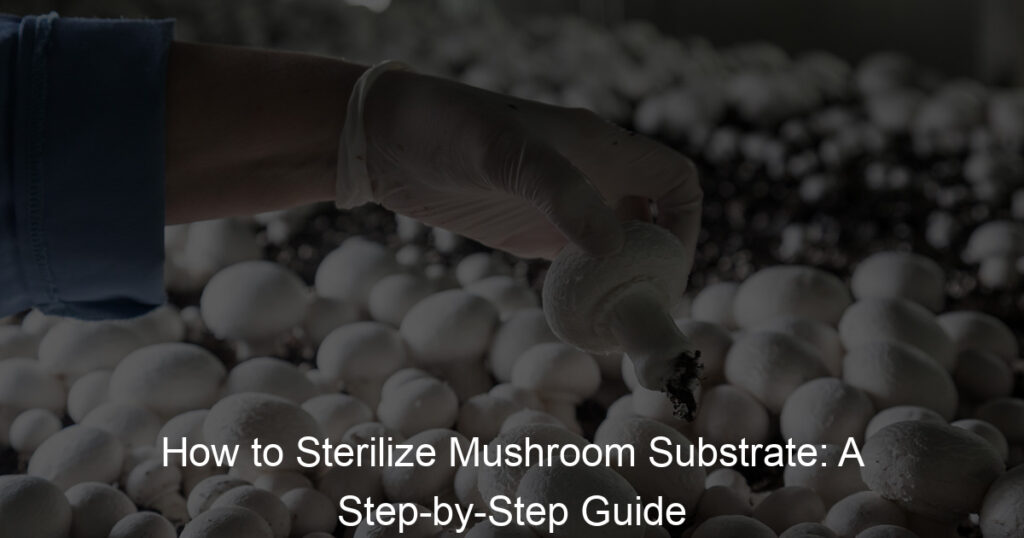Have you ever wondered how to sterilize mushroom substrate? If so, you’re in luck! This step-by-step guide will show you exactly how to do it. Keep reading to learn more!
How do you sterilize mushroom substrates?
Sterilizing mushroom substrates is an important step to ensure a successful, healthy harvest. There are several ways to do this: the most common methods are steam sterilization or pressure cooking with chemical agents such as Formaldehyde, Chlorine dioxide, and hydrogen peroxide. Steam sterilization is easy to implement and can be done using simple kitchen equipment such as a pot, a lid, newspaper, foil, and water.
Chemical agents require more specialized equipment and careful measuring of pH levels to achieve the best success rate. Whichever method is chosen, all substrates must be sterilized correctly for mushrooms to flourish.
What are the substrate sterilization methods?
Substrate sterilization is an important part of laboratory safety. It ensures that all biological materials and equipment used in an experiment do not run the risk of being contaminated with other microorganisms. Many methods exist for sterilizing substrates, though some are more effective than others. Heat sterilization is one of the most common techniques available and involves heating items to kill off any potential contaminants.
Autoclaving is a form of heat sterilization that subjects items to high temperatures, pressure, and steam to remove pathogenic organisms from them. Chemical disinfectants can also be used, though care must be taken as some may be fatal to human cells or cause allergic reactions in delicate organisms such as plants.
UV radiation is another popular substrate sterilization method that uses ultraviolet light to reduce microbial populations on surfaces. Therefore, researchers have plenty of options available when it comes to substrate sterilization depending on the type of equipment and material they’re working on within their experiments – so they don’t have to worry about contamination!
What are the sterilization techniques for mushrooms?
Mushroom sterilization is a critical step in the process of cultivating them for food. Heat treatment and steam sterilization are the two main techniques used to sanitize mushroom cultures, making them free from any potential contaminants or disease-causing organisms. Heat treatment involves increasing the temperature to approximately 55 degrees Celsius, while steam sterilization requires exposing the culture to high pressure and/or moisture.
Both methods require close monitoring, as heat and steam can cause irreversible damage if not handled with care. Mushroom farmers must employ these sterilization techniques to ensure their product is safe for consumption. Done right, they can enjoy delicious harvests of healthy mushrooms!
How do you sterilize mushroom substrate steam?
Sterilizing mushroom substrate via steam is a fairly straightforward process that doesn’t require any complicated equipment – all you need is a pot and some water. The goal of this method is to kill off any bacteria and other organisms that may be present, which can impact the quality of your mushrooms.
To start the sterilization process, simply place your substrate into the pot, cover it with a lid, and bring it to a boil over high heat. Once boiling has been achieved, reduce the heat to low-medium and allow the mixture to continue boiling for an additional 20-30 minutes. This should be enough time to effectively kill off any foreign organisms and ensure that your substrate is safe for reuse.
How do you sterilize bulk substrate at home?
Sterilizing bulk substrates at home can be a tricky process, but it doesn’t have to be overwhelming! There are two basic methods you can use – one requires a pressure cooker and the other uses hot water, both of which will help you achieve a sterile substrate safely. When using a pressure cooker, make sure it’s filled up with no more than two-thirds of its capacity with the substrate, and follow the manufacturer’s instructions when filling and sterilizing.
Otherwise, hot water works just as well; boil one part of your chosen substrate in four parts of water for one hour before straining and cooling down. Once cooled, your substrate is ready for use! While neither method is foolproof, if done correctly they both offer a low-cost way to ensure healthy mushrooms.
At what temperature do you sterilize the mushroom substrate?
When it comes to sterilizing mushroom substrates, the ideal temperature to do so is around 180-200 degrees Celsius (or 360-400 Fahrenheit). This type of heat helps to kill off a lot of bacteria and unwanted diseases that can ruin your crop in the long run.
To achieve this temperature, most people will either use an oven or a pressure cooker as both are capable of producing consistently high temperatures. That said, there is also the option of steam sterilization which is heavily dependent on how much pressure you can generate, as well as how often you turn over the substrate during the process.
Final thoughts: How to Sterilize Mushroom Substrate: A Step-by-Step Guide
Overall, learning how to sterilize mushroom substrate is an essential component of successful mushroom cultivation. Following the steps outlined in this post can help you get the best results out of your mushrooms and prevent any potential contamination issues.
Before attempting to sterilize any substrate, be sure to take necessary safety precautions such as wearing gloves and a mask, as well as having proper ventilation when boiling any substances. Additionally, always use high-quality straws, hardwoods, manure, and peat moss for the most desirable substrate. With patience and our guide, you’ll be well on your way toward producing cloned mushrooms with ease!








